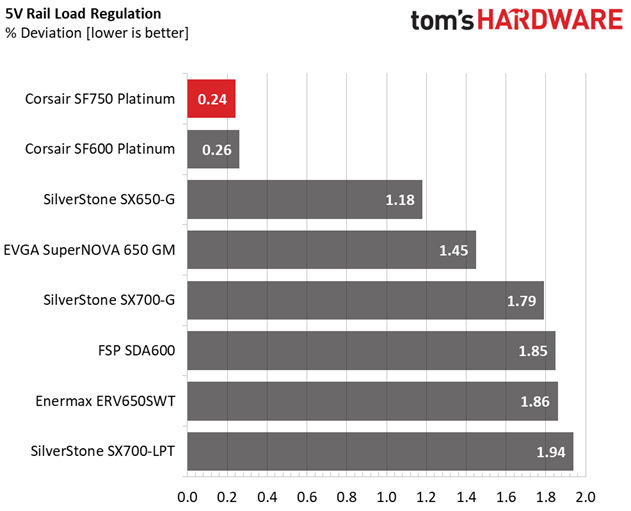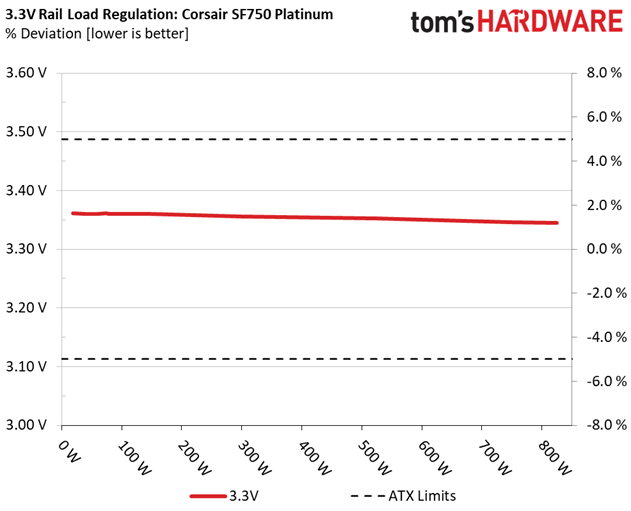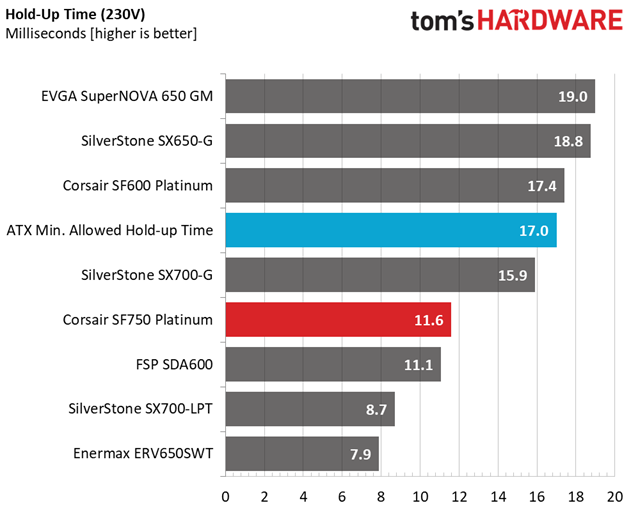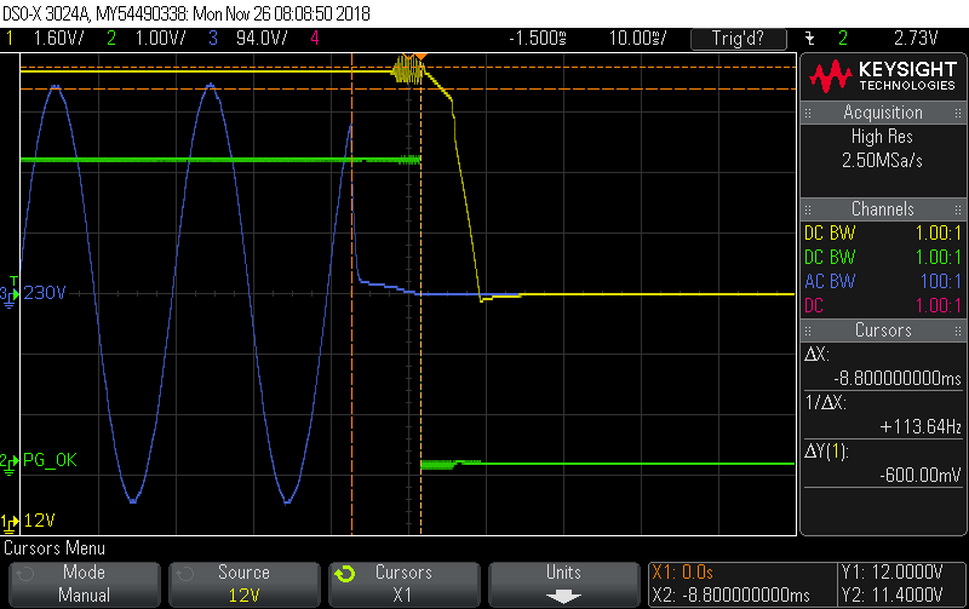Corsair SF750 PSU Review: A Tiny Power Factory
Why you can trust Tom's Hardware
Load Regulation, Hold-Up Time, Inrush Current, Efficiency and Noise
To learn more about our PSU tests and methodology, please check out How We Test Power Supply Units.
Primary Rails And 5VSB Load Regulation
The following charts show the main rails' voltage values recorded between a range of 40W up to the PSU's maximum specified load, along with the deviation (in percent). Tight regulation is an important consideration every time we review a power supply because it facilitates constant voltage levels despite varying loads. This regulation improves the system’s stability, especially under overclocked conditions and, at the same time, it applies less stress to the DC-DC converters that many system components utilize.








Hold-Up Time
Put simply, hold-up time is the amount of time that the system can continue to run without shutting down or rebooting during a power interruption.







The hold-up time is this product's Achilles' heel. It is too low because of the small bulk cap in the APFC converter. The power ok signal is accurate, but it is very low as well.
We also notice some notable turn-off overshoot at +12V, which needs to be addressed.
Inrush Current
Inrush current, or switch-on surge, refers to the maximum, instantaneous input current drawn by an electrical device when it is first turned on. A large enough inrush current can cause circuit breakers and fuses to trip. It can also damage switches, relays, and bridge rectifiers. As a result, the lower the inrush current of a PSU right as it is turned on, the better.


The inrush current is low when used with 115V, but this is not the case with 230V input.
Get Tom's Hardware's best news and in-depth reviews, straight to your inbox.
10-110% Load Tests
Those tests reveal the SF750’s load regulation and efficiency levels under high ambient temperatures. They also show how the fan speed profile behaves under tough operating conditions.
| Test # | 12V | 5V | 3.3V | 5VSB | DC/AC (Watts) | Efficiency | Fan Speed (RPM) | PSU Noise (dB[A]) | Temps (In/Out) | PF/AC Volts |
|---|---|---|---|---|---|---|---|---|---|---|
| 1 | 4.387A | 1.973A | 1.961A | 0.994A | 74.402 | 87.060% | 0 | <6.0 | 40.36°C | 0.941 |
| 12.038V | 5.069V | 3.361V | 5.029V | 85.461 | 46.52°C | 115.05V | ||||
| 2 | 9.839A | 2.959A | 2.947A | 1.195A | 149.290 | 90.769% | 0 | <6.0 | 40.67°C | 0.965 |
| 12.033V | 5.067V | 3.360V | 5.023V | 164.473 | 47.57°C | 115.04V | ||||
| 3 | 15.693A | 3.454A | 3.424A | 1.395A | 224.798 | 91.788% | 0 | <6.0 | 41.48°C | 0.973 |
| 12.031V | 5.066V | 3.358V | 5.017V | 244.911 | 49.44°C | 115.04V | ||||
| 4 | 21.482A | 3.948A | 3.933A | 1.596A | 299.577 | 92.039% | 0 | <6.0 | 41.93°C | 0.980 |
| 12.028V | 5.064V | 3.356V | 5.012V | 325.488 | 50.47°C | 115.04V | ||||
| 5 | 26.935A | 4.938A | 4.915A | 1.799A | 374.556 | 91.783% | 1363 | 13.2 | 42.23°C | 0.985 |
| 12.031V | 5.064V | 3.355V | 5.005V | 408.090 | 52.15°C | 115.05V | ||||
| 6 | 32.388A | 5.927A | 5.901A | 2.001A | 449.464 | 91.415% | 1516 | 18.1 | 42.84°C | 0.989 |
| 12.031V | 5.063V | 3.354V | 4.999V | 491.674 | 53.78°C | 115.04V | ||||
| 7 | 37.878A | 6.917A | 6.893A | 2.204A | 524.787 | 90.898% | 2033 | 27.5 | 43.44°C | 0.991 |
| 12.030V | 5.061V | 3.352V | 4.992V | 577.337 | 54.73°C | 115.04V | ||||
| 8 | 43.375A | 7.906A | 7.880A | 2.407A | 600.118 | 90.240% | 2691 | 35.2 | 43.70°C | 0.992 |
| 12.028V | 5.060V | 3.350V | 4.986V | 665.024 | 56.06°C | 115.04V | ||||
| 9 | 49.237A | 8.404A | 8.362A | 2.409A | 674.640 | 89.567% | 3210 | 40.0 | 44.59°C | 0.993 |
| 12.026V | 5.059V | 3.348V | 4.983V | 753.228 | 58.12°C | 115.04V | ||||
| 10 | 55.100A | 8.901A | 8.875A | 2.511A | 749.785 | 88.769% | 3723 | 44.3 | 45.98°C | 0.994 |
| 12.025V | 5.057V | 3.346V | 4.978V | 844.649 | 60.26°C | 115.03V | ||||
| 11 | 61.359A | 8.903A | 8.881A | 2.513A | 825.003 | 87.888% | 3879 | 44.7 | 46.74°C | 0.995 |
| 12.024V | 5.056V | 3.345V | 4.975V | 938.701 | 62.50°C | 115.03V | ||||
| CL1 | 0.141A | 16.005A | 16.000A | 0.000A | 136.603 | 85.739% | 1744 | 21.9 | 42.00°C | 0.965 |
| 12.043V | 5.067V | 3.363V | 5.032V | 159.324 | 52.82°C | 115.06V | ||||
| CL2 | 62.514A | 1.000A | 1.000A | 1.000A | 765.140 | 89.163% | 3678 | 43.8 | 45.16°C | 0.994 |
| 12.025V | 5.060V | 3.346V | 5.003V | 858.132 | 60.64°C | 115.03V |
The semi-passive operation lasts for quite long, given this unit's high power-density. The fan profile is relaxed at up to the 70% load test, but the fan's speed notably increases afterwards.
20-80W Load Tests
In the following tests, we measure the SF750's efficiency at loads significantly lower than 10 percent of its maximum capacity (the lowest load the 80 PLUS standard measures). This is important for representing when a PC is idle, with power-saving features turned on.
| Test # | 12V | 5V | 3.3V | 5VSB | DC/AC (Watts) | Efficiency | Fan Speed (RPM) | PSU Noise (dB[A]) | PF/AC Volts |
|---|---|---|---|---|---|---|---|---|---|
| 1 | 1.195A | 0.492A | 0.475A | 0.198A | 19.459 | 71.556% | 0 | <6.0 | 0.865 |
| 12.025V | 5.069V | 3.361V | 5.042V | 27.194 | 115.04V | ||||
| 2 | 2.458A | 0.985A | 0.983A | 0.397A | 39.857 | 81.721% | 0 | <6.0 | 0.911 |
| 12.026V | 5.069V | 3.360V | 5.039V | 48.772 | 115.05V | ||||
| 3 | 3.655A | 1.479A | 1.455A | 0.596A | 59.355 | 85.602% | 0 | <6.0 | 0.936 |
| 12.030V | 5.068V | 3.360V | 5.035V | 69.338 | 115.04V | ||||
| 4 | 4.918A | 1.973A | 1.963A | 0.795A | 79.788 | 87.741% | 0 | <6.0 | 0.949 |
| 12.036V | 5.068V | 3.360V | 5.031V | 90.936 | 115.05V |
The unit's fan isn't engaged under light loads, even at higher than 35°C ambient temperatures.
Efficiency
Next, we plotted a chart showing the SF750’s efficiency at low loads, and loads from 10 to 110 percent of its maximum-rated capacity. The higher a PSU’s efficiency, the less energy goes wasted leading to a reduced carbon footprint, besides lower electricity bills.




The SF750 has very high efficiency levels under both normal and light loads.
5VSB Efficiency
| Test # | 5VSB | DC/AC (Watts) | Efficiency | PF/AC Volts |
|---|---|---|---|---|
| 1 | 0.100A | 0.505 | 72.350% | 0.096 |
| 5.045V | 0.698 | 115.05V | ||
| 2 | 0.250A | 1.261 | 83.344% | 0.186 |
| 5.042V | 1.513 | 115.06V | ||
| 3 | 0.550A | 2.772 | 84.926% | 0.304 |
| 5.038V | 3.264 | 115.06V | ||
| 4 | 1.000A | 5.033 | 84.674% | 0.387 |
| 5.033V | 5.944 | 115.06V | ||
| 5 | 1.500A | 7.540 | 83.379% | 0.432 |
| 5.026V | 9.043 | 115.07V | ||
| 6 | 2.500A | 12.535 | 83.439% | 0.472 |
| 5.013V | 15.023 | 115.06V |


The 5VSB rail is highly efficient, as you can see in the charts above.
Power Consumption In Idle And Standby
| Mode | 12V | 5V | 3.3V | 5VSB | Watts | PF/AC Volts |
|---|---|---|---|---|---|---|
| Idle | 12.016V | 5.061V | 3.353V | 5.046V | 5.876 | 0.472 |
| 115.0V | ||||||
| Standby | 0.048 | 0.007 | ||||
| 115.0V |


The vampire power is kept low.
Fan RPM, Delta Temperature, And Output Noise
All results are obtained between an ambient temperature of 37°C (98.6°F) to 45°C (116.6°F).
The fan's passive operation lasts for quite long and the fan profile is not aggressive, even under tough operating conditions.
The following results are obtained at 30°C (86°F) to 32°C (89.6°F) ambient temperature.
Under normal temperatures, the fan speed profile is quite relaxed, especially if we take into account this unit's extremely high power density.
MORE: Best Power Supplies
MORE: How We Test Power Supplies
MORE: All Power Supply Content
Current page: Load Regulation, Hold-Up Time, Inrush Current, Efficiency and Noise
Prev Page Specifications and Part Analysis Next Page Protection Features, DC Power Sequencing, Cross-Load Tests and Infrared Images
Aris Mpitziopoulos is a contributing editor at Tom's Hardware, covering PSUs.






